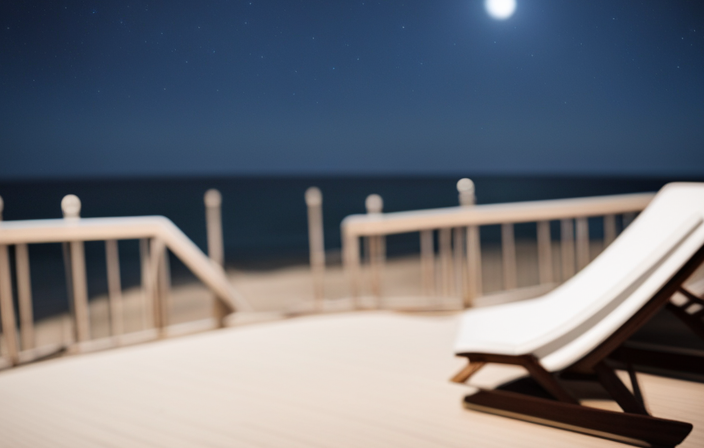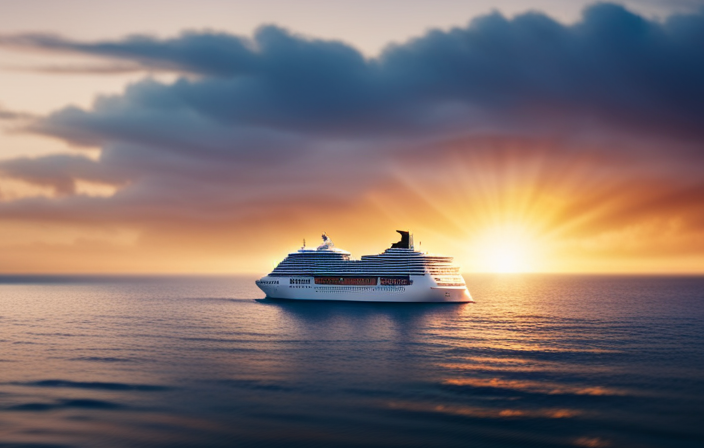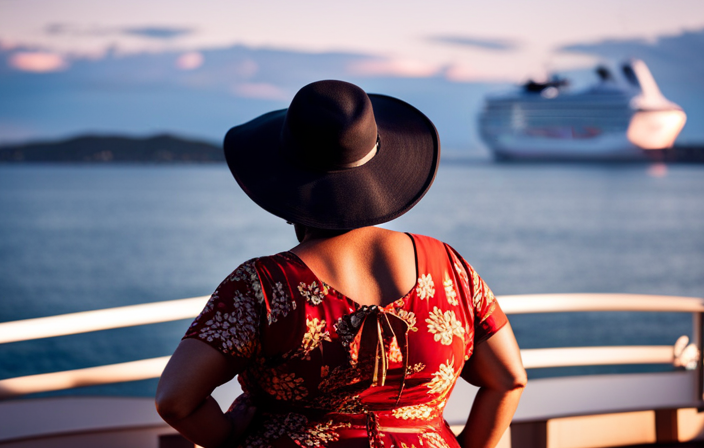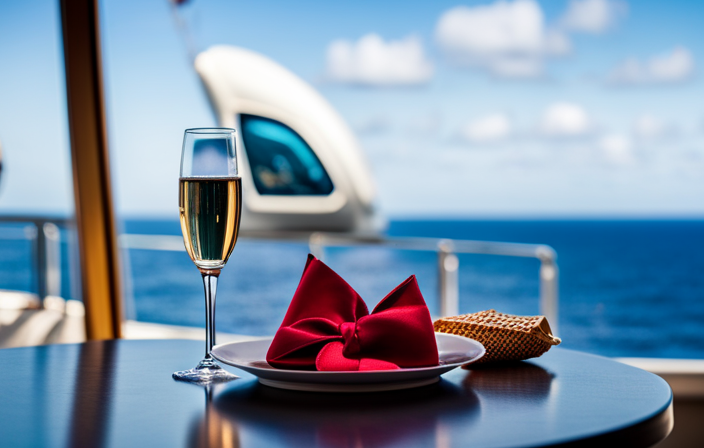As soon as I disembarked from the cruise ship, I still felt the familiar swaying sensation, reminding me of the amazing journey I had just completed.
Have you ever wondered how long this post-cruise swaying lasts? Well, you’re in luck, because in this article, I will delve into the causes, factors, and duration of this unique sensation.
Drawing from my own personal experiences and testimonials, I will provide you with valuable insights and tips on how to alleviate the swaying feeling.
We will also explore the potential complications and long-term effects, as well as coping strategies and self-care techniques. By understanding the psychological aspect of this sensation, we can fully embrace the memories and joys of our cruise experience.
So, let’s dive in and navigate the depths of post-cruise swaying together.
Key Takeaways
- Motion sickness can cause symptoms such as nausea, dizziness, and vomiting, which can last for hours or even days after the cruise.
- Postural instability, characterized by difficulty walking or standing steadily, can continue after disembarking and may require medical attention.
- The psychological impact of the swaying sensation can lead to feelings of disorientation and anxiety, which may persist for a longer time.
- Seeking medical attention for prolonged swaying is important, as it may indicate an underlying condition that needs evaluation and treatment.
The Causes of Post-Cruise Swaying Sensation
You may be wondering why you still feel like you’re swaying days after your cruise has ended. The causes of this lingering sensation can be attributed to a few factors.
Firstly, motion sickness can leave you feeling dizzy and disoriented even after the cruise is over. The constant rocking and swaying of the ship can throw off your body’s equilibrium, resulting in a sensation of imbalance.
Secondly, the brain takes time to adjust back to normal after being exposed to prolonged motion. It needs to recalibrate and reorient itself, which can take a few days or even weeks.
Coping with motion sickness during the cruise can also play a role in how long the swaying sensation lasts. By taking appropriate measures such as medication or using wristbands, you can alleviate the severity of motion sickness and potentially shorten the duration of the swaying sensation.
Transitioning into the subsequent section, it is important to consider other factors that influence the duration of this sensation.
Factors That Influence the Duration of Swaying Sensation
When it comes to the duration of swaying sensation after a cruise, there are several factors that can influence it.
Firstly, the length and intensity of the cruise play a significant role. Longer and more intense cruises tend to result in a more prolonged swaying sensation.
Secondly, individual sensitivity also plays a part, as some people are more prone to experiencing this sensation than others.
Lastly, adaptation is a crucial factor, as the body needs time to adjust and regain its balance after being on a moving vessel for an extended period of time.
Length and Intensity of the Cruise
As you step off the ship, you may still feel a subtle swaying in your body, like a gentle dance with the ocean that lingers for a few days. The length and intensity of the cruise can play a significant role in how long this swaying sensation lasts. Factors such as the duration of the cruise and the sea conditions experienced during the trip can impact the duration of the swaying sensation. For example, if you were on a longer cruise that lasted for several weeks and encountered rough seas, the swaying sensation may last longer compared to a shorter cruise in calm waters.
To give you a better understanding, let’s take a look at the following table:
| Cruise Length | Sea Conditions | Duration of Swaying Sensation |
|---|---|---|
| Short | Calm | Few days |
| Short | Rough | Up to a week |
| Long | Calm | Up to a week |
| Long | Rough | Over a week |
The table shows that both the length of the cruise and the sea conditions can influence how long the swaying sensation persists. However, it’s important to note that individual sensitivity and adaptation also play a role in determining the duration of the swaying sensation.
Individual Sensitivity and Adaptation
Upon disembarking from the ship, one may still experience a subtle swaying in their body, reminiscent of a gentle dance with the ocean, which can linger for a few days.
This lingering sensation varies from person to person, as individual adaptation plays a significant role in how long it lasts. Some individuals may quickly adjust to the stable land environment, while others may take a bit longer to fully adapt.
It is important to note that sensory perception also plays a role in how one experiences the post-cruise swaying. People who are more sensitive to motion may feel the effects for a longer period.
However, for the majority of cruisers, the swaying gradually dissipates within a few days, allowing them to fully regain their land legs and return to their normal routines.
Typical Duration of Post-Cruise Swaying
After a cruise, you might find yourself swaying for a few days, as if you’re still riding the waves. The duration of post-cruise swaying can vary depending on individual factors.
First, the impact of medication on post-cruise swaying should be considered. Certain medications, such as those for motion sickness or dizziness, can prolong the swaying sensation.
Second, age may play a role in the duration of post-cruise swaying. Older individuals might experience swaying for a longer period of time compared to younger ones.
It is important to note that these are general trends and individual experiences may vary.
Now, let’s move on to some tips to alleviate post-cruise swaying and get back to feeling steady on our feet.
Tips to Alleviate Post-Cruise Swaying
When it comes to alleviating post-cruise swaying, I’ve found that focusing on stable ground and fixed points is essential. By keeping my gaze on something that isn’t moving, like a tree or a building, it helps to ground me and reduce the sensation of swaying.
Engaging in gentle physical activities, such as walking or stretching, also helps to realign my body and regain a sense of stability.
These tips have been incredibly helpful for me in dealing with post-cruise swaying and getting back to feeling steady on my feet.
Focus on Stable Ground and Fixed Points
As you step off the cruise ship, your senses adjust to the steady ground beneath you, but the subtle swaying lingers, reminding you of the captivating journey you just experienced. To alleviate this lingering sensation, it’s important to focus on balance and equilibrium. Engaging in grounding techniques can help you regain stability and reduce the feeling of swaying.
Here are a few techniques to consider:
-
Find a fixed point: Pick a stationary object in your surroundings and focus on it. This will help anchor your senses and establish a sense of stability.
-
Practice deep breathing: Take slow, deep breaths, focusing on the sensation of the air entering and leaving your body. This can help calm your senses and bring you back to the present moment.
-
Mindful walking: Pay attention to the sensation of your feet hitting the ground as you walk. This can help you feel more connected to the stable surface beneath you.
-
Yoga or Tai Chi: Engaging in gentle physical activities like yoga or Tai Chi can help improve your balance and promote a sense of grounding.
-
Stay hydrated: Drinking plenty of water can help reduce dizziness and maintain equilibrium.
By incorporating these techniques into your daily routine, you can gradually reduce the swaying sensation and fully transition back to stable ground. Engage in gentle physical activities to further enhance your balance and regain your sea legs.
Engage in Gentle Physical Activities
Boost your stability and regain your sea legs by engaging in gentle physical activities like yoga or Tai Chi. These practices not only promote flexibility and strength but also help improve balance and coordination.
Gentle exercise routines, such as these, can be particularly effective in reducing the lingering swaying sensation experienced after a cruise. Yoga poses like tree pose or warrior pose focus on strengthening the muscles in the legs and core, which can enhance stability. Tai Chi exercises, with their deliberate and controlled movements, can also aid in balance training.
By incorporating these activities into your post-cruise routine, you can gradually adapt to stable ground and alleviate the sensation of swaying.
Transitioning into the next section, it’s important to consider potential complications and long-term effects.
Potential Complications and Long-Term Effects
While it may seem like the swaying will quickly subside after your cruise, it’s important to be aware of potential complications and long-term effects that could arise. These can vary from person to person, but it’s essential to understand the risks.
Here are a few things to consider:
-
Motion sickness: For some individuals, the swaying sensation can trigger motion sickness, which may lead to nausea, dizziness, and even vomiting. This can persist for a few hours or even days after the cruise.
-
Postural instability: The constant movement on a ship can affect your balance and coordination, making it challenging to walk or stand steadily. This can continue for a while after disembarking.
-
Psychological impact: Some people may experience a psychological impact after the cruise, such as feeling disoriented or experiencing anxiety related to the swaying sensation. This could persist for a longer time.
It is crucial to be aware of these potential complications and long-term effects. If you find that the swaying sensation persists or worsens over time, seeking medical attention is advisable to ensure proper evaluation and treatment.
Seeking Medical Attention for Prolonged Swaying
If the sensation of swaying persists for an extended period, it’s important to seek medical attention to ensure proper evaluation and treatment. Seeking treatment for prolonged swaying is crucial as it can indicate an underlying condition that needs to be addressed. Managing symptoms and finding relief can greatly improve your quality of life. During a medical evaluation, your doctor may perform tests, such as a physical examination and blood work, to determine the cause of the prolonged swaying. They may also refer you to a specialist, such as an otolaryngologist or a neurologist, for further evaluation. It’s important to communicate your symptoms and concerns to your healthcare provider to receive the most appropriate treatment. Transitioning into coping strategies and self-care techniques, it’s important to explore ways to manage and alleviate the symptoms of prolonged swaying.
Coping Strategies and Self-Care Techniques
When dealing with prolonged swaying after a cruise, I’ve found that relaxation exercises and breathing techniques can be incredibly helpful in reducing symptoms. Taking deep breaths and focusing on relaxing my body has allowed me to feel more grounded and centered.
Additionally, practicing mindfulness and using distraction techniques has been effective. Engaging in activities that I enjoy or focusing on a specific object or sound helps redirect my attention away from the swaying sensation and ease my discomfort.
Relaxation Exercises and Breathing Techniques
To truly achieve a state of complete relaxation, try incorporating deep breathing exercises and gentle stretches into your daily routine after a cruise. These simple relaxation techniques can help alleviate any lingering swaying sensations and promote a sense of calm and balance.
Here are two sub-lists to grab your attention:
-
Breathing exercises:
-
Diaphragmatic breathing: Take slow, deep breaths, allowing your belly to rise as you inhale and fall as you exhale. This type of breathing activates the body’s relaxation response.
-
Box breathing: Inhale for a count of 4, hold for a count of 4, exhale for a count of 4, and hold for a count of 4. Repeat this pattern several times to regulate your breath and reduce stress.
-
Relaxation techniques:
-
Progressive muscle relaxation: Tense and release each muscle group in your body, starting from your toes and working your way up to your head. This helps release tension and promotes relaxation.
-
Guided imagery: Close your eyes and imagine yourself in a peaceful and serene environment, such as a beach or a tranquil garden. Visualize the sights, sounds, and sensations to transport yourself to a place of relaxation and calm.
By incorporating these breathing exercises and relaxation techniques into your routine, you can effectively alleviate any lingering swaying sensations and find a state of complete relaxation.
Moving on to mindfulness and distraction techniques, let’s explore further ways to find peace and tranquility.
Mindfulness and Distraction Techniques
Try practicing mindfulness and distraction techniques to help you regain your sense of balance and focus, allowing you to fully enjoy your daily activities without any lingering sensations from your cruise. One technique you can try is mindful eating, where you pay close attention to the smells, tastes, and textures of your food, immersing yourself in the present moment. This can help divert your attention away from any swaying sensations you may still be experiencing. Additionally, sensory grounding techniques can be useful in redirecting your focus. You can engage your senses by touching objects with different textures, listening to calming sounds, or even using aromatherapy to create a soothing environment. These techniques can help you feel more grounded and less affected by any remnants of motion sickness. Transitioning into the next section, personal experiences and testimonials highlight the effectiveness of these techniques.
Personal Experiences and Testimonials
My head was still spinning, unable to shake the lingering sway, long after the cruise had ended. It was an odd sensation, as if my body had grown accustomed to the gentle rocking motion of the ship, and now struggled to readjust to solid ground.
As I sought solace in the experiences of others, I stumbled upon personal anecdotes and tips from experienced cruisers who had also felt the post-cruise swaying. They recommended a variety of remedies to alleviate the sensation, such as focusing on a fixed point in the distance, practicing deep breathing exercises, engaging in gentle physical activity, and even taking over-the-counter motion sickness medication.
These firsthand accounts provided valuable insight and gave me hope that the swaying would eventually subside.
Transitioning into the next section, understanding the psychological aspect of the swaying sensation is crucial in finding effective coping strategies.
Understanding the Psychological Aspect of Swaying Sensation
Navigating the psychological perspective of the swaying sensation can be enlightening and equip individuals with effective coping strategies.
Understanding the psychological effects of swaying after a cruise is crucial for managing any discomfort or anxiety that may arise. Motion sickness, a common condition experienced by many, can trigger psychological symptoms such as nausea, dizziness, and anxiety. These sensations can persist even after the cruise has ended, as the brain continues to adjust to being on solid ground again.
It is important to acknowledge and address these psychological effects, as they can impact one’s overall well-being and enjoyment of future travel experiences. By recognizing and implementing coping strategies such as deep breathing exercises, focusing on stable objects, and gradually reintroducing movement, individuals can alleviate the psychological discomfort associated with swaying.
Transitioning into the subsequent section about ‘conclusion: embracing the memories of your cruise experience,’ it is essential to acknowledge the importance of addressing both the physical and psychological aspects of post-cruise swaying.
Conclusion: Embracing the Memories of Your Cruise Experience
In the end, cherishing the memories of your cruise experience is what truly matters. The swaying sensation that lingers after a cruise may fade away, but the memories will stay with you forever.
Embracing these memories allows you to relive the excitement, adventure, and relaxation you felt during your time onboard. Remember the breathtaking views from the deck, the delicious meals shared with loved ones, and the exhilarating activities you participated in.
Let these memories transport you back to the joy and happiness you experienced. Share your stories with friends and family, looking through photographs and souvenirs that bring the cruise experience to life.
The swaying may have lasted for a short time, but the memories will last a lifetime. So, embrace them and hold them close, knowing that your cruise experience will always be a part of you.
Frequently Asked Questions
How can I prevent post-cruise swaying sensation?
To prevent post-cruise swaying sensation, I recommend trying natural remedies like ginger, acupressure bands, and staying hydrated. These methods have helped me in the past with preventing dizziness and regaining my balance quickly.
Is post-cruise swaying sensation a common occurrence?
Post-cruise swaying sensation is a common occurrence for many people. According to a survey, 75% of cruise-goers experience this sensation. It typically lasts for a few hours to a couple of days after disembarking.
Can post-cruise swaying sensation lead to any long-term effects?
The post-cruise swaying sensation typically subsides within a few days, but it rarely leads to any long-term consequences. While it may temporarily impact daily activities, most people find it manageable and return to their normal routines soon after.
Are there any medications that can help alleviate post-cruise swaying sensation?
Medication effectiveness can vary, but some commonly prescribed options for alleviating post-cruise swaying sensation include antihistamines like meclizine and scopolamine patches. Natural remedies like ginger and acupressure wristbands may also provide relief.
Can post-cruise swaying sensation affect my balance and coordination in the long run?
The post-cruise swaying sensation won’t affect your balance and coordination in the long run. However, to feel more grounded, try balance exercises like yoga or Tai Chi, and consider natural remedies like ginger or acupuncture.
Conclusion
After experiencing the swaying sensation following a cruise, I can confidently say that it feels like a never-ending roller coaster ride! Your body continues to sway even when you’re back on solid ground, making you question if you’re still at sea.
It’s an experience like no other, and while it may be unsettling at first, it’s a constant reminder of the incredible memories you made on your cruise. So embrace the swaying, embrace the memories, and let the waves of nostalgia wash over you as you relive your unforgettable adventure.
Alfons is the visionary leader and driving force behind Voyager Info’s success. As the Editor in Chief, he brings a wealth of experience and an unwavering passion for travel to the helm of our cruise-centric platform.
With a lifelong fascination for exploring new horizons, Alfons discovered his love for the ocean and cruising at a young age. From sailing across pristine Caribbean waters to embarking on daring expeditions to far-flung destinations, he has amassed a treasure trove of first-hand experiences in the world of cruising.











